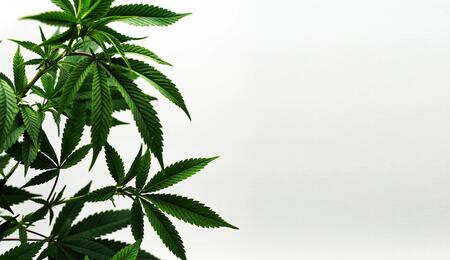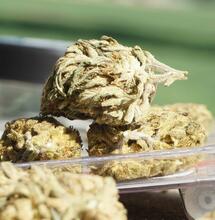Dinamed, the queen of Switzerland

For some months now, Dinamed has exploited the existence in Switzerland of a legal market in CBD-rich cannabis flowers with less than 1% THC content and started to grow large crops of this product. Dinamed has therefore become a quality reference in the Swiss market.
H. Madera A few months ago, at Dinafem’s headquarters we saw a presentation of their CBD-rich strain, Dinamed, with a CBD to THC ratio of 10:1. CBD normally ranges between 10% and 14%, whereas THC between 0.5% and 1%. In that previous article, we explained that Dinafem had developed and marketed Dinamed with mainly charitable purposes, as a CBD dominant strain for any medical user. Although its recreational use was also mentioned, its medical use was its main source of attraction. The generosity implied in making this genotype commonly available was then rewarded by a surprisingly new demand for that product, and when Dinamed was first marketed in Switzerland, market demand exploded. Although this plant evoked great public interest on the conventional cannabis scene, both among medical consumers and recreational growers, it is its success in Switzerland that has crowned Dinamed as a particularly successful product.
CBD-dominant strains in Switzerland
During its pioneering activity in the Swiss market, Dinafem saw this market grow and mature in only a few months. Initially, it was a typical young market, which absorbed any product coming in, with many commercial tricks used to make the product known to unknowledgeable end consumers; for instance, Dinafem initially sold industrial hemp grown outdoors in other countries and dipped into synthetic terpenes to give it a pungent smell and conceal its origin. As a classical gimmick, hemp was given names in high demand, such as Skunk, Widow or Haze. Currently the Swiss market is going through a second, more mature phase, so using any name is no longer appropriate, as consumers require quality, plant selection and strains grown in greenhouses, or however indoors. In this phase, Dinamed has the advantage of looking like conventional cannabis, except for its cannabinoid content. Buds look nice, dense and smell pleasantly, without needing any terpene addition. Its smoking is tasty and the produced smoke is dense, given the high resin quantity. It also has a relaxing body effect. For this reason, people at Dinafem believe that the future of CBD-rich cannabis goes well beyond hemp, as the market requires strains bred to resemble mainstream cannabis plants, high in CBD and low in THC. Ultralight cannabis strains are likely to expand even more in the coming months. A reason behind the success of Dinamed in Switzerland is its low THC content, normally around 0.5%, so thousands of these plants can be grown with no risk of exceeding a 1% THC content. Dinafem, however, is aware that other markets require different amounts of cannabinoids, so they are working on another version of Dinamed.
The global market in CBD-rich cannabis
It should be added that other markets are following suit. For example, in Italy flowers of strains certified in Europe as industrial hemp are sold, which can be smoked or vaporised. In other countries, CBD-rich hash processed with industrial hemp is also offered. This is a recreational type of market that nobody had so far foreseen. All of a sudden, in many European stores, dried buds of cannabis or even hash are appearing. Some users have now replaced tobacco with cannabis, as they consider it more natural. This habit will soon become popular all over Europe, then in the USA and finally in the rest of the world. The demand created by legal crops will cause a rise in the growing of CBD-rich strains with different concentrations, aspects and tastes. In any case, what we call THC-rich plants normally have a CBD content below 0.1%. On the other hand, plants normally termed ‘CBD-rich’ have a THC content of less than 1% as is the case for Switzerland, or even less than 0.3% as is the case for Italy. This process has caused a dazzling increase in the demand in CBD-rich and THC-poor plants. In the past, recreational use was confined to THC-rich strains. Subsequently, strains with a THC to CBD ratio of 1:1 have gradually appeared, and now CBD-rich strains are all the rage for their legality.
Dinamed crops in Switzerland
The role of Dinafem was chiefly to supply seeds. Swiss cannabis growers need no coaching. Reference should also be made to a recent trend in Switzerland, which only lasted for a short period of time until 2005 and consisted in growing cannabis crops on a large scale. This trend contributed to create a large community in favour of cannabis growing, which has now got off the ground without any problem. Although climate in Switzerland is harsh, with cold nights in autumn, Dinamed had adapted perfectly to these conditions, without moulding issues and is also grown on extensive crops. Swiss growers also appreciate its good germination, one of the major growers we interviewed said it had purchased 40,000 seeds and reported only 10 plants having failed to reach the germination process. Seeds were germinated on pressed peat cakes called ‘jiffies’. From this substrate they were then transplanted to greenhouses, with around 3 square metres of space per plant and a good-quality growing substrate. To combat plant pests, our interviewed grower kept basil nurseries in the greenhouse. Dinamed seedlings were transplanted in late June and continued to grow vigorously throughout summer into slender plants, with broad branches and a medium to tall size. Other aspects that are appreciated by Swiss growers include homogeneity, with thousands of plants very similar to each other. Some specimens also developed a nice purple colour in autumn and were all harvested in early October (although, of course, in warmer climates they can be harvested earlier).
Conclusions
In large-scale growing tests made in Switzerland, Dinamed performed very well in terms of germination, vigour, homogeneity and end-product quality, with high CBD and low THC contents. Dinafem will shortly launch another version with a different cannabinoid ratio. The market in CBD-rich strains suggests a different use of recreational cannabis, and reverses the common beliefs that recreational cannabis has to be high in THC and that CBD is reserved for medical use only. A group of users prefer its subtler effect, they feel more comfortable as the effect is less noticeable, i.e. they can smoke a CBD-only joint and continue working or doing anything else. It is something similar to alcohol-free beer, although the body effect in this case will be one of slight relaxation. Users say they “feel it in their body, but not in their brain”, and some are very attracted to and enjoy this effect. CBD will increasingly become a new marketing pathway for recreational cannabis in Europe and its dissemination is likely to grow substantially, especially among consumers who consider THC-rich cannabis too strong. This leads us to the conclusion that the culture of cannabis and its applications is booming, which will produce a much broader perception of cannabis, with the opportunity to exploit its various effects.



